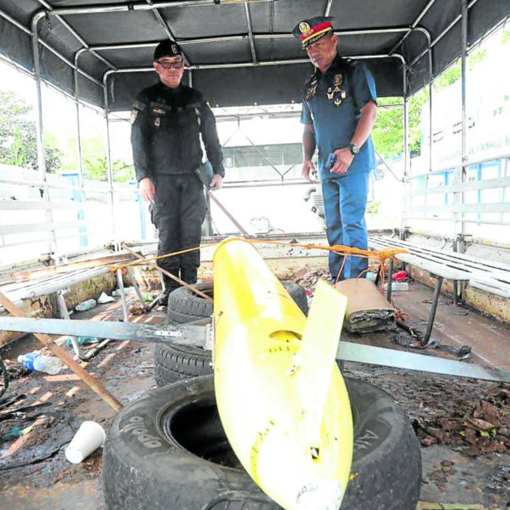Unexpected Discovery of Chinese Drone Found in Masbate Waters Under Investigation
The Philippine Navy is currently delving into the origins and purpose of an underwater drone adorned with Chinese characters, which was found off the coast of San Pascual in Masbate province.
This intriguing device, discovered by three local fishermen approximately nine kilometers from Iniwaran village, has captured the military's attention due to its potential applications in intelligence and surveillance operations. The investigation seeks to unravel the mysteries behind this unusual find.
The discovery took place on a tranquil Monday morning when three fishermen encountered a torpedo-shaped drone adrift at sea. This device, measuring around two meters in length, featured fins, an antenna, and a visual lens. It bore the code "HY-119," which, upon further investigation through open-source internet research, was identified as a reference to a Chinese underwater navigation and communication system.
Collaboration between Military and Police
Upon its discovery, the drone was initially handed over to the police, who subsequently transferred it to the Armed Forces of the Philippines (AFP) for a comprehensive investigation. Colonel Xerxes Trinidad, head of the AFP's public affairs office, confirmed that the remotely operated submersible drone is being meticulously examined to determine its origins and capabilities. Brigadier General Andre Dizon, Bicol regional police director, noted that the drone is intended for monitoring and reconnaissance activities.

Concerns and Implications
Although the drone was unarmed, its recovery has raised substantial concerns due to its potential use in intelligence, surveillance, target acquisition, and reconnaissance (ISTAR) operations. This incident occurs amid ongoing maritime tensions between the Philippines and China over contested territories in the West Philippine Sea.
An anonymous source from the intelligence community revealed that similar devices have previously been retrieved in nearby waters, including Chinese buoys off Catanduanes. These drones are typically utilized for reconnaissance and surveillance—activities not typically found within the Armed Forces of the Philippines' (AFP) inventory.
The Police Regional Office Region 5 highlighted the significant implications of recovering such advanced underwater technology, as it offers insights into naval capabilities. Authorities are meticulously examining the device to evaluate its impact on national security and maritime operations. Local police units have been instructed to coordinate with fisherfolk and coastal communities to report any sightings of similar objects and to avoid touching or moving them.
Military and Scientific Insights into Drone Recovery
Colonel Trinidad commended the collaboration between local fishermen and maritime stakeholders in recovering the drone. He assured the public that the Armed Forces of the Philippines (AFP) remains dedicated to safeguarding the country's maritime domain, utilizing all necessary resources to address similar situations effectively. Microbial oceanographer Deo Florence Onda, an associate professor at the University of the Philippines Diliman-Marine Science Institute, pointed out the challenges in determining whether such drones are used for military surveillance or research without accessing the specific data collected. He highlighted that both ocean research and surveillance can employ similar technologies.
Chinese research vessels have been observed on the eastern side of the Philippines, including the resource-rich Philippine (formerly Benham) Rise. Notably, in April 2024, a Chinese-flagged research vessel was spotted near Viga in Catanduanes province, and in October of the same year, two Chinese fishing boats were sighted off the coast of Casiguran in Aurora province.
The ongoing presence of Chinese ships remains a point of contention due to their persistent activities in various parts of the West Philippine Sea, which lie well within Manila's 370-kilometer exclusive economic zone.

